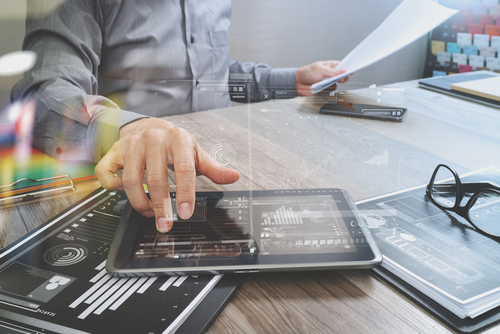With an estimated 2.7 billion people (or 80% of the global workforce) having been affected by COVID-19-related lockdowns, returning to work isn’t an event; it’s a process of recovery, efficiency and resilience. For businesses to survive the present and thrive into the future, they will need to adopt technological advances that will help them work smarter, safer and more sustainably.
In this article, Smarter Technologies CEO, Bradley Wingrave, discusses the ways in which smart, connected technologies are helping businesses to safely reopen their doors.
Recovery
The first step in reopening businesses post-lockdown is to enter the ‘recovery’ stage, whereby workplaces and processes adjust to a ‘new normal’. As we progress into the recovery stage, businesses will need to ensure their workplaces and office spaces are equipped to prevent the spread of the virus.
Businesses, government agencies and commercial property owners need to adhere to local and national safety guidelines, which include:
- Staff screening
- Checks for shared spaces
- Desk occupancy
- Social distancing
- Cleaning status
Fever scanning technology
The presence of fever is a common symptom of COVID-19, which is why scanning individuals for high temperatures is recommended while reopening workspaces.
Although some businesses have resorted to using hand-held temperature scanners, these are not a preferred solution for a number of reasons, including poor accuracy and inefficiency. A more effective solution is the use of thermal imaging cameras with facial recognition that report into a central dashboard and send real-time alerts if fever is detected in an individual.
Different cameras can provide different functions, such as smaller cameras for access control and larger cameras for crowd scanning. With all cameras in a workspace linked to a cloud-based software dashboard, relevant staff have access to employee health data and automated reporting. Along with fever monitoring, this data can be used to monitor sickness days, employee working hours, and the exit and entry of visitors and employees.
Smart hygiene
Companies that are reopening are looking for ways to replace high-touch items with smart, automated or mechanised alternatives, using technology to mitigate risk, keep employees safe and work environments clean. Examples of this include voice-activated controls for elevators and doors and smart lighting that can be controlled remotely or activated by motion sensors, instead of light switches.
Efficiency
All stakeholder groups, especially employees, have increased expectations for physical, emotional, financial, and digital safety. This begs the question of how organisations can improve overall safety without placing unrealistic burdens on their resources.
Part of the answer lies in smart buildings and offices that use connected devices and smart office applications. Integrated cameras, sensors and devices can provide critical workplace safety functions required under COVID-19 protocols, minimising the need for manual, resource-heavy interventions.
Some of the functions performed by smart building technologies include:
- Occupancy monitoring
- Cleaning management
- Automated water temperature testing and flushing
- Air and ventilation monitoring
- Temperature monitoring
- Fire safety
- Lighting control
- Building energy management
All of these enable businesses to implement safety measures and procedures with the ease of automation, empowering staff with accurate data to better inform decision-making. Another consideration is that these technologies enable remote building management, which means that building managers no longer need to be on site to monitor and manage various aspects of their facility for safety and compliance.
Resilience
To be truly resilient, a business can’t simply return to where it left off before the crisis. Rather, a resilient organisation is one that has transformed and is moving forward faster than ever before.
With employees still encouraged to work remotely where possible, the use of videoconference and cloud-enabled file-sharing has become critical. Companies looking to ensure business continuity in the long term should find ways to embed these technologies in workplace processes to empower employees to work remotely. This may require some degree of digital transformation in order to seamlessly integrate cloud-based software and systems. In some cases, employees may even be replaced by ‘virtual employees’ with artificial intelligence (AI).
Perhaps, in some ways, the COVID-19 pandemic has forced us to put a foot on the accelerator when it comes to digital adoption. Our now virtual lifestyles have changed the perception of what’s possible, which has challenged the role of the physical environment and traditional workplace processes.
In closing, here are some tips for recovery, efficiency and resilience:
- Develop a staggered return-to-work plan.
- Use rigour in determining which functions, work, and roles need to return to the physical workplace.
- Develop policies and plans in accordance with the latest guidance on testing, safety, and sanitation.
- Support teams working remotely with seamless technology solutions that enable effective collaboration and task management.
- Anticipate HR scenarios such as family situations, pay disputes and work refusals.
- Consider other support that you can provide to improve the mental and physical wellbeing of your staff.
- Establish feedback channels.
- Understand and comply with legal requirements.
- Assess what supplemental technology and tools you can use to achieve your objectives in a compliant, safe, cost-effective and efficient manner.
|
Smarter Technologies tracks, monitors and recovers assets across the globe in real time, providing asset tracking systems to the open market and fulfilling the world’s most complex asset tracking requirements. Our services cover a vast array of business sectors, products and equipment from container or pallet tracking to military-grade devices; and can be used across a broad spectrum of industries. As a leading IoT company, we also provide smart building solutions for modern businesses, offering wire-free, battery-powered and low-cost IoT smart sensor technology. Our solutions will put an end to scheduled maintenance and help businesses utilize their building’s efficiency, benefitting from real-time alerts and facilities management tools that will bring them into the 21st century. |


 Bradley Wingrave is a successful serial entrepreneur and CEO of Smarter Technologies. Having run numerous successful businesses, Bradley is dedicated to leveraging the power of technology to streamline business operations in the UK and beyond.
Bradley Wingrave is a successful serial entrepreneur and CEO of Smarter Technologies. Having run numerous successful businesses, Bradley is dedicated to leveraging the power of technology to streamline business operations in the UK and beyond.